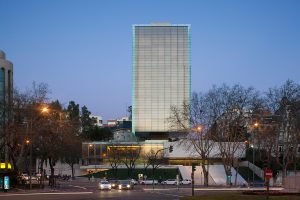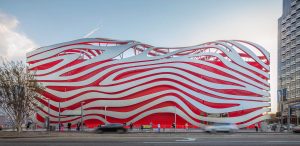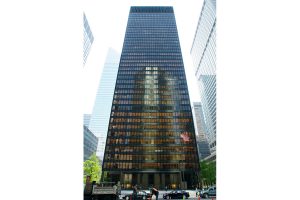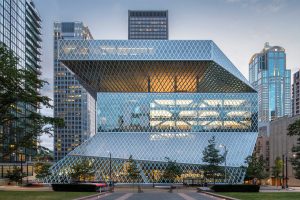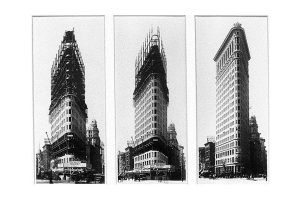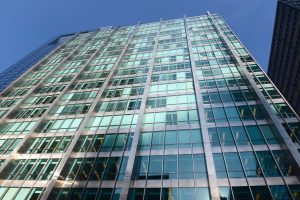The US Steel Tower, a lasting beacon on the Pittsburgh skyline and legacy of Andrew Carnegie
Pittsburgh’s tallest, most massive skyscraper is a multifaceted paradox of elegance and clumsiness, success and failure. The US Steel Tower later renamed the USX Tower is an emblematic building both for the city of Pittsburg and the US steel industry. This 64 storey office building culminates above the city at 256 m. At its completion in 1970, the U.S. Steel Building seemed like a monument to the triumph of the steel industry. In a city full of corporate headquarters such as Gulf, Westinghouse, Alcoa, and Koppers, U.S. Steel would be the largest in town, indeed the tallest building between New York and Chicago.
Founded in 1901 by J. P. Morgan, Andrew Carnegie, Elbert Gary and Henry Moore the giant U. S. Steel Corporation was ranked as the world’s most valuable company worth $492 million or $15 billion in today’s money. In 1902, only their second year of business, U. S. Steel made approximately 67% of all the steel produced in the USA. In 1943 the company employed 340,000 people. At the very peak of its steel production in 1953, the company produced 23 million tons of steel.
Before working on the design of the US Steel Tower Harrison, Abramovitz & Abbe had recently completed the aluminium clad headquarters building for Alcoa Corp. also located in Pittsburgh. Basing themselves on the shape of downtown Pittsburg which is known as ‘The Golden Triangle’ they came up with a triangular floor plan with indented corners rather than the more traditional square or rectangular floor plans in use for nearly all other towers. The Tower still boasts the world record for the world’s tallest building with a completely flat roof.
The US Steel building culminates above Pittsburgh’s Golden Triangle, a bustling downtown district located at the confluence of the two main tributaries of the Ohio River
The US Steel building is the tallest skyscraper in Pittsburgh and contains over 44,000 U.S. tons of structural steel, and almost an acre of office space per floor.This aerial view taken during construction reveals its triangular floor plan with indented corners as well as its exterior structural columns
Elevation of the U.S Steel Tower. The US Steel building is 841 ft high (256,3 m) with 64 storeys above ground making it the tallest skyscraper in Pittsburgh. It contains over 44,000 U.S. tons of structural steel and almost an acre of office space per floor.
COR-TEN an innovative steel product both for industry, and the world of art and architecture
U. S. Steel Corporation developed in 1933 a new weathering steel patented as COR-TEN. This steel product was made up of a group of steel alloys which were developed to eliminate the need for painting, and form a stable rust-like appearance after several years’ exposure to weather. Because of its exceptional mechanical resistance Corten was originally intended for rail carts carrying bulk products. The benefits of using this steel was that it did not require painting or expensive maintenance due to rust. Cor-Ten forms a protective layer of dark brown oxidation on its exposed surface and became very popular in industrial product designs. It also gained a lot of attraction in the art world. In 1967 the city of Chicago took possession of a monumental 147 ton sculpture designed by Picasso in Cor-Ten steel. Once the artist had approved the final mock-up, its manufacturing was put out to tender. U. S. Steel won the contract with its bid of $351,959.17 (approximately $2.8 million today) and its fabrication took place in their Gary Works production unit in Indiana.
Picasso’s massive Cubist sculpture was designed for the City of Chicago. It weighed 147 tons and was built in Cor-Ten by U. S. Steel in their Indiana production unit.
Photography by J. Crocker
The US Steel Tower project was another opportunity to showcase Cor-ten towards architectural circles. So Harrison & Abramovitz came up with a design that highlighted its steel structure as much as possible. To do so they introduced eighteen structural columns made in Corten on the exterior of the building. Conventionally the structural steel frame of a tall building would have either a concrete coating or would be sprayed with a fireproof coating. Curtain walling would then cover up the structural steel.
To allow the eighteen structural columns to remain visible, the engineers came up with an ingenious solution for the building. They filled the steel columns with half a million gallons of water mixed with antifreeze. This approach to fireproofing columns was common in bridges. Using the liquid-filled columns meant that the entire structural steel frame had to be perfectly watertight and leakproof.
From a rusty dinosaur to a lasting icon
Unfortunately the U. S. Steel Tower was completed just before the first oil shock occurred in 1973 marking the slow decline of the US steel manufacturing industry. In 1989 after a bitter strike, U. S. Steel shut three of their steel manufacturing plants, firing 3 500 union positions. Globalisation accelerated the demise of heavy industry so that the thriving ‘Factory Belt’ gradually became known as ‘The Rust Belt’ leading to massive changes in demography and socio-economic conditions. By 2001 U. S. Steel’s market share had fallen to 8% of domestic consumption. Nowadays the corporation employs approximately 29,000 people with a market value of $1.1 billion.
To make matters worse, the giant rusty steel tower seemed to highlight exactly the wrong quality of steel to immortalise. It didn’t help either that the Cor-Ten steel columns started flaking off tiny bits of iron oxide in the rain – as if a dying industry was crying over its imminent death. The rust then stained the sidewalks around the building into the same rusty color as the building. As the next generation of skyscrapers brought color, ornament, distinctive profiles, and well-planned plazas back to the Pittsburgh architecture, the U.S. Steel Tower seemed both haughty and shamefaced by comparison.
But substantive architecture can withstand the fluctuations of taste. Over the last five years some $60 million have been invested into the US Steel Tower particularly in terms of energy efficiency so that it is now the second-largest LEED Silver Certified office building in the world. The building’s spectacular lobby, has been entirely renovated while maintaining much of its restrained detailing in ample glass and exposed structure to become a first class venue. Certain changes have also been made to the interior design to adapt the office space to present day requirements. But the architecture of the building remains as evocative as ever of the 1970s. It remains to be seen if new buildings elsewhere can portray their own historical period as effectively as the U.S. Steel Building still does.

